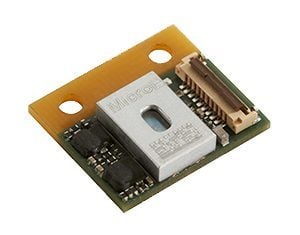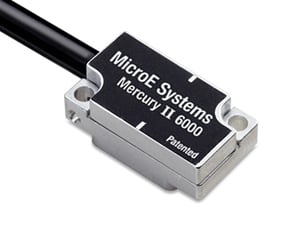An optical encoder is an electromechanical device that uses a light source, photosensitive detectors, and an optical grating to convert rotary or linear position to an electrical signal.

Optical Encoder implementations
There are three primary implementations:
- Transmissive
- Reflective
- Interferential
The interferential optical encoder is the clear leader in terms of precision, as shown in the table (right). Interferential and reflective technologies make small size and low weight possible. The transmissive encoder is typically in an enclosure and can be more rugged depending on the rating of the enclosure. The higher precision of the interferential encoder demands tighter alignment tolerances, but the requirements are not onerous considering the resolution and accuracy of the device.

Optical Encoders definition – Interferential

An interferential optical encoder operates by a coherent laser light source generating a diverging beam, which illuminates a diffraction grating pattern printed on the scale. The grating pattern is created using either chrome deposition on a glass scale, or laser written lines on a metal tape scale. The 20µm pitch grating diffracts the light to generate a high contrast interference pattern of bright and dark, directly back onto a detector array. Inherently incremental, a second index/marker track is typically used.
The diffracted light creates discrete Talbot planes of interference patterns. In the example below, the 3rd Talbot plane is utilized. As the relative position of the scale and detector changes, the diffraction pattern translates across the detector array, resulting in a sinusoidal change in each detector cell.
Strengths and weaknesses of interferential optical encoders
| Strengths | Weaknesses |
| High resolution, accuracy, repeatability, compact, moderate alignment tolerances | Environmental ruggedness for Talbot plane implementation |
Click to read our Technical Paper ‘Incremental Optical Encoder Technologies’ to learn more about how each technology works and the relative pros and cons.
Celera Motion Optical Encoders
Celera Motion’s optical encoders are primarily interferential. The interferential encoder is the clear leader in terms of precision and this technology make small size and low weight possible. Find more information about our optical encoder products by selecting below;
Optical Encoder Applications
Optical encoders are used in a wide range of applications that require monitoring or control, or both, of mechanical systems. These applications include;
Surgical robotics
Diagnostic imaging
Radiation therapy
Microfluidic Dispensing
Robotic Arm End Effector
Laser Cataract Surgery
Photonics
Precision Photonics Stage
DNA Sequencing









